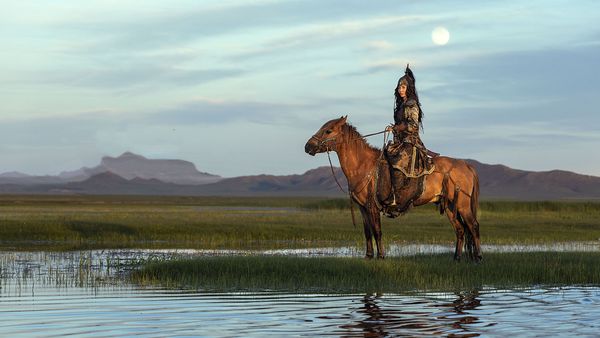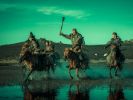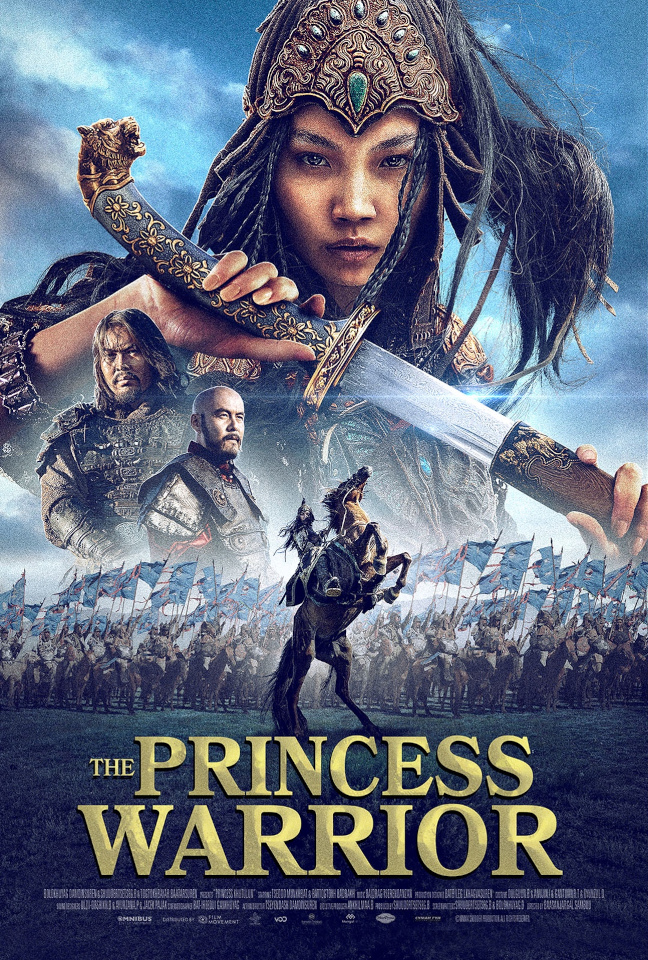Eye For Film >> Movies >> The Princess Warrior (2021) Film Review
The Princess Warrior
Reviewed by: Jennie Kermode

In every age, in every part of the world where women are valued less than men, there have been those who resisted, who excelled at supposedly masculine skills and sought to claim masculine space for themselves. Most of them are footnotes in history, their stories often tragic; the vast majority were never remembered at all. Every now and again, though, one succeeded so spectacularly that history is not enough, and the story of what follows becomes legend. In Mongolia, the greatest such story belongs to Khutulun.
Ever since Khutulun’s story made it out into the wider world – thanks in part to Marco Polo – people have been trying to rewrite it, to tame her. Though elements of her story influenced Red Sonja, she is best known in the West in the form of Turandot, her well-attested martial prowess stripped away, her fate twisted into a conventional romance. Mongolia’s film industry is small and under-resourced, and it is onlt during the past three decades that it has gradually acquired the means to tell its own stories. here, directors S Baasanjargal and Shuudertsetseg Baatarsuren reclaim Khutulun in all her glory, finally doing justice to the woman who was perhaps the world’s most notable warrior princess.

Inevitably, the story has been reshaped a little. Historical sources suggest that the real Khutulun was always supported by her father, King Kaidu, in her fighting and shooting skills, but she would have faced wider social approbation, so here we get the shortcut of a father who wants her to become a lady, skilled in needlecraft, whilst her friends recognise her for the warrior she is. This band of loyal allies is introduced at the start in dramatic poses, with names flashed up on the screen, which – along with the colour-saturated scene that follows – might lead Western viewers to expect something trashy, but although it features a lot of hand-to-hand fighting and fantasy elements, this is a serious film with some impressive work in it.
Those fantasy elements derive from Mongolian spiritual tradition and are important to situating the action in its proper context. In a brief prelude we see our heroine as a child, speaking with her grandmother, who gave her the name Ayurug – ‘Moonlight’ – and who promises to guide her through life using secret signs. Not just there to provide colour, this scene will help us to understand some of Khutulun’s subsequent decision-making, as well as ensuring that outsiders don’t go away with the impression that those women who did accept traditional female roles were wholly powerless. It helps to pave the way for the subsequent appearance in the film of a female sorcerer of sorts, who represents a distinct form of threat. Of course, one might also note that laying claim to sorcerous powers was a means by which a woman could develop a career as a tactician.
The central narrative is fairly straightforward, exploring the tensions between Kaidu and another figure of legend, Kublai Khan. When Kaidu is attacked and a precious scroll stolen (more than just a random McGuffin when one considers that it was only through reference to such scrolls that the rule of law could be maintained), Khutulun (now played by Tsedoo Munkhbat) sets off, without permission, to try and retrieve it. Along the way she is attacked by a variety of foes, including ninjas, and must cunning as well as martial skill in order to locate and confront her principal enemies.
Khutulun was famous for her ability to beat male warriors in the celebrated national sport of wrestling, and although Munkhbat has a slender build, she convinces as someone with the skill and reflexes to pull this off. Although the choreography is a little uneven, the fight scenes are interesting, with none of the showing off or pursuit of personal glory that we see in most such films. The warriors work as a team, each willing to drop back into support mode or simply focus on self defence when another is in a better position to take the lead. Khutulun’s athletic prowess is notable but the film takes it time before engaging her in high stakes single combat.
Being Mongols, of course, they also do some of their fighting on horseback. These are not the big, muscular horses treated as status symbols by Western knights, nor are they the fast but fragile racehorse types who also make their way into film from time to time. They’re real Steppe horses, short and stout, long-haired and pony-like in their proportions yet quite capable of carrying bulky warriors for long distances. In the combat scenes they’re absurdly manoeuverable, and perform impressive stunts with apparent ease. Together with the way that bows are used, this makes it easy to see how the Mongols dominated the region for centuries.
Despite working with a relatively small cast, the filmmakers manage to achieve something of the epic quality necessary for a film about such an important historical figure, and though the script may sometimes feel unsophisticated, that is in part because it’s unabashed about putting the home audience first rather than catering to the expectations of the international cinema community. It makes stunning use of Mongolia’s greatest asset, its natural landscape, and succeeds condensing many aspects of Khutulun’s real story into a lively and entertaining actioner.
Reviewed on: 06 Mar 2024
















